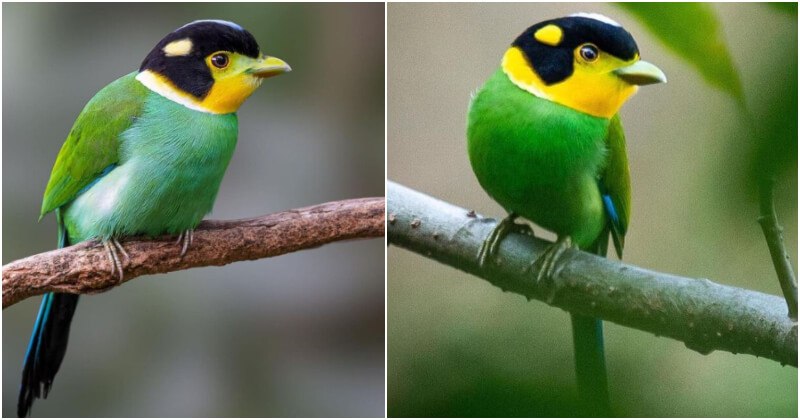We can’t get enough of the cuteness of tiny and chubby birds. When they put on a one-of-their-kind coat, we can never our eyes off them. These birds are too perfect to be true. Their striking plumage makes them conspicuous whenever they turn up. Mother nature actually favors them.

Image Credits: Instagram/eye_spy_birds
The long-tailed broadbill is among these outstanding birds. It has a fluorescent green coat and a yellow face and throat with a yellow patch behind each eye. Noticeably, it wears a black helmet-like cap with a beautiful blue patch on top. This enchanting blue shade also appears on the wings and tail, making this bird look like a flying gem.

Image Credits: Instagram/kallol_mukherjee_photography
You can watch the video of this striking bird below.
Young birds do not get the beautiful coat of the adults. They have a shorter tail, green head, and generally overall duller plumage.

Image Credits: Instagram/simon_li_at_noiz
The long-tailed broadbill is a non-migratory species. They are typically found in a region in the Himalayas, in Myanmar, South-East Asia, the Malay Peninsula, Sumatra, and Borneo.

Image Credits: JJ Harrison (https://www.jjharrison.com.au/) / CC BY-SA 3.0
These birds prefer living in forests, streams and creeds, tropical and subtropical lowland forests, and tropical, subtropical moist mountain forests.

Image Credits: Instagram/birdsinwild
As this species distributes widely, their population is currently stable. It’s listed least concern on the ICUN Red list of threatened species.

Image Credits: Instagram/chungbasherpa.photography
This bird’s main diet is mall insects. But they sometimes feed on frogs, berries and some fruits if there are available nearby.

Image Credits: Instagram/458scuderia
During the breeding season, female long-tailed broadbill builds her large pear-shaped nest. This nest is made from fine roots, dead leaves, creepers, and moss and is attached to the branch of a tall tree. She then lays 6 eggs in her nest, incubates them, and feeds the hatchlings until fully fledged.

Image Credits: Instagram/simon_li_at_noiz
If you love this bird, just share the article with your family and friends.
H/T: One Big Birdcage
